Published on
Updated on
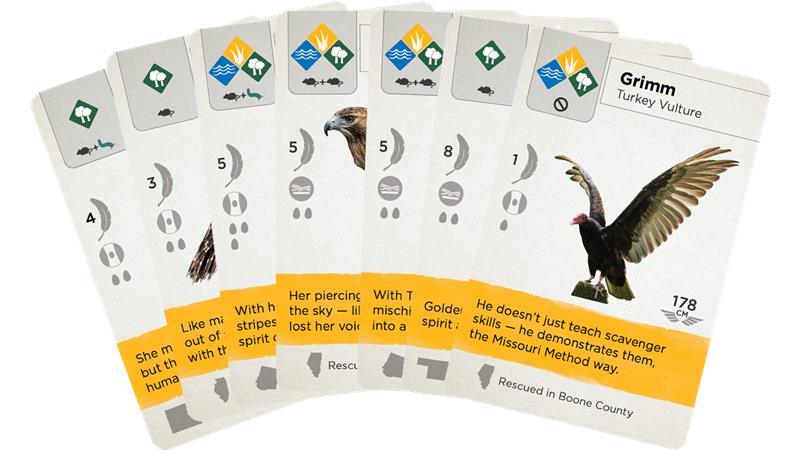
Contact: Cary Littlejohn, carylittlejohn@missouri.edu
Photos by Abbie Lankitus
At the University of Missouri, even the birds have school spirit.
At Mizzou, owls, hawks, falcons and vultures help train the next generation of veterinarians through the Raptor Rehabilitation Project in the College of Veterinary Medicine.
The Raptor Rehabilitation Project gives students real-world experience caring for injured birds of prey that have collided with cars, flown into buildings or fallen from their nests.
Some recover and return to the wild. Others — unable to hunt for themselves — stay on as “education birds,” helping the public and future veterinarians better understand raptors, Lizette Somer, the project manager, said.
The idea is to make learning about birds memorable, hands-on and fun.
“You can spout words at people all day long, and what they retain may be minimal,” Somer said. “But if they actually get to see the bird, it piques and keeps their interest and leaves a larger, lasting impression on them.”
That’s one reason she’s a fan of Wingspan, the award-winning bird-themed game that mixes strategy with stunning artwork and fascinating bird facts.
The game’s popularity has resulted in expansion packs based on specific locations, such as Europe, Asia and Oceania, to provide additional birds for players to activate.
With the game as inspiration, Somer shared facts about the education birds from the Raptor Rehabilitation Project.
Introducing Wingspan, the Mizzou edition.
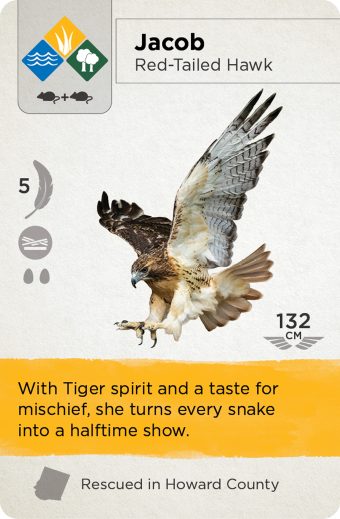
Name: Jacob
Common Bird Name: Red-tailed hawk
Home turf:
Howard County, Missouri
Origin story:
Named by a fourth-year veterinary medicine student (and still rocking the name 16 years later), Jacob was found grounded during her first year of life. X-rays revealed a chronic wing fracture that never healed quite right. While she can’t fly, she glides with style and struts her stuff like a campus legend.
Why she’s here:
Left wing’s not flight-ready, but everything else? Sharp as ever. Especially the talons.
Feathered fun fact:
Jacob is the unofficial queen of the enclosure. She hunts and stages snakes like trophies, draping them dramatically over her perch to startle unsuspecting humans before proudly digging in. Dinner and a show? Classic Jacob.
Tiger spirit:
Whether she’s waggling her tail on a glove or walking campus with her handler, Jacob thrives in the spotlight. She’s a veteran of the Missouri Method — training humans by example for more than a decade.
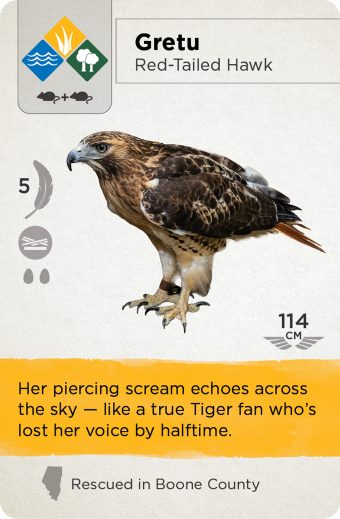
Name: Gretu
Common bird name: Red-tailed hawk
Home turf:
Boone County, Missouri
Origin story:
Originally named Patrick Henry, this fierce raptor got a name upgrade when she joined the education team. “Gretu” is the Missouri tribe’s word for hawk.
Why she’s here:
Found grounded in Boone County, Gretu had injuries that limit her ability to fly long distances. She’s strong, steady and makes short flights — but she won’t be migrating anytime soon.
Feathered fun fact:
You’ve definitely heard birds like Gretu before even if you didn’t know it. Hollywood often swaps in red-tailed hawk cries for bald eagles in movies because the hawk’s raspy scream sounds more majestic. She’s got the voice of a starlet and the eyes of a sniper, spotting prey from a perch with vision six times more powerful than a human’s.
Tiger spirit:
Her raspy scream rivals the roar of Tiger fans on game day — loud, proud and impossible to ignore. She’s Mizzou-strong, Missouri-proud and screen-ready.
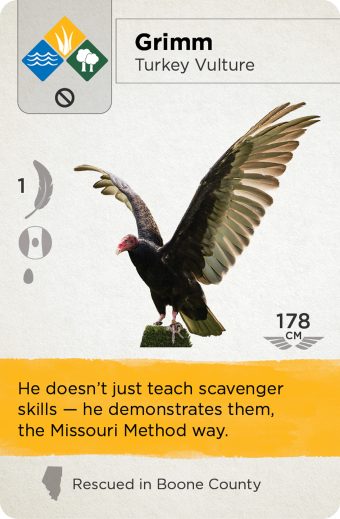
Name: Grimm
Common Bird Name: Turkey vulture
Home turf:
Boone County, Missouri
Origin story:
Originally named “Turkey,” this young vulture was in rough shape when he arrived — head trauma, facial paralysis and one damaged eye later removed. His chances looked grim, so when he beat the odds and joined the education team, the name Grimm stuck.
Why he’s here:
A probable car strike near Stadium Boulevard left him grounded with permanent injuries. He’s non-releasable but fully unflappable.
Feathered fun fact:
Despite his spooky stare and hooked beak, Grimm is a fan favorite. He rouses and preens proudly during presentations and even plays with toys that let him act out natural scavenging behaviors. He teaches crowds that vultures are nature’s clean-up crew — fighting disease, protecting ecosystems and saving humans from the gross stuff.
Tiger spirit:
Grimm’s got the heart of a true Tiger: courageous, curious and confident. His hiss may not match a stadium roar, but his message is loud and clear: turkey vultures rock.
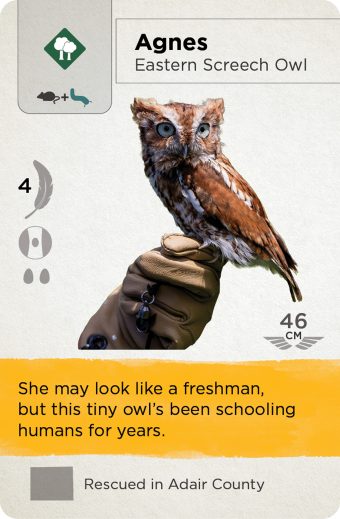
Name: Agnes
Common Bird Name: Eastern screech owl
Home turf:
Adair County, Missouri
Origin story:
Agnes tumbled from a barn nest just days after hatching. Kind-hearted humans brought her inside and cared for her, imprinting her during a critical phase. She came to Raptor Rehab already bonded to people — and perfectly suited for a new role as a feathered educator.
Why she’s here:
Early human care caused her to imprint with people for life. She can’t survive in the wild but thrives in the spotlight.
Feathered fun fact:
Agnes is a rufous morph Eastern screech owl, meaning her feathers glow with a rich, reddish hue. Her species is a dietary overachiever — known to eat more than 250 different kinds of prey — and they fly in signature “U-shaped” arcs from perch to perch.
Tiger spirit:
Tiny but mighty, Agnes fools everyone — mistaken for a baby, a plush toy or a prop — until she blinks. But behind that cuteness is a wise, red-feathered ambassador with her eyes on the prize and usually, her handler. A true Tiger knows how to keep the crowd guessing.
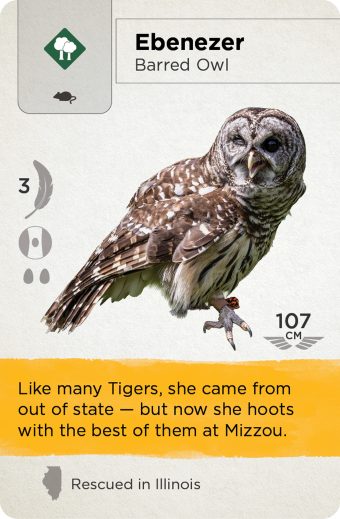
Name: Ebenezer (Eb)
Common Bird Name: Barred owl
Home turf: Illinois
Origin story: There are no “bah humbugs” when Ebenezer’s around. When she was admitted in the cold of December, there seemed no better inspiration for a name than Charles Dickens’ famous miser-turned-merry protagonist, Mr. Scrooge. But friends call her Eb.
Why she’s here: Eb’s hunting days were cut short when she was presumably struck by a car, which left her with head trauma and injuries to both eyes.
Feathered fun fact: Eb is a talker. You can often hear her distinctive call — which sounds like “Who cooks for you?” — and she’s fond of chit-chatting with the wild barred owls that neighbor the Raptor Rehab facility.
Tiger spirit: A lot of Tigers come from outside of Missouri, and Eb’s living proof. Barred owls don’t usually leave a tight six-mile radius from where they were hatched, but just like the students who come from all over the world, she’s found a home at Mizzou.
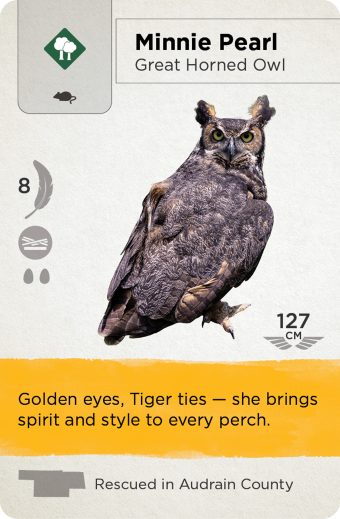
Name: Minnie Pearl
Common Bird Name: Great horned owl
Home turf: Audrain County, Missouri
Origin story: Minnie Pearl charms crowds at educational presentations just the same as her namesake, the famous country singer and comedian, did at the Grand Ole Opry.
Why she’s here: Minnie Pearl arrived at Raptor Rehab with a dislocated right elbow, which left her unable to fly.
Feathered fun fact: Despite being unable to fly, she loves activities. Minnie Pearl enjoys nice walks in the woods. And she’s always ready to play — nearly every day, she’ll take an egg-shaped dog toy and hide it in her enclosure for her feeders to find.
Tiger spirit: Don’t let Minne Pearl’s eyes fool you. Though she’s an owl, hers are the eyes of a tiger — a Mizzou Tiger. Crowds are often amazed at her large gold eyes with their pit-black pupils. From her perch as an educational bird, she’s likely done with the thrill of the fight—and her handlers hope she won’t have any need to rise to the challenge of her rivals — but a little Tiger pride goes a long way when educating young Missourians.
Early experience, real impact: Inside Mizzou’s Raptor Rehab
The Raptor Rehabilitation Project provides incredible learning opportunities for students at Mizzou’s College of Veterinary Medicine. Students here already get more clinical experience than students at many vet schools because Mizzou’s curriculum is designed for two years of clinicals rather than just one. But Jen Pederson and Grace McIntosh, both now in their fourth years, say the raptor program gives students even earlier access.
Students can take a raptor class in their first year, where they learn to handle the education birds before getting that early hands-on experience, McIntosh said.“Very few programs give students direct experience as early as ours. Even in the first year, we perform husbandry, handle feedings, administer medications and get involved in the cases,” she said.
Students then progress to an on-call status where primary physicians, who are more experienced students such as Pederson and McIntosh, give less experienced students an opportunity to assess injured birds during intake.
Primary physicians at the Raptor Rehabilitation Project shoulder the most responsibility for the birds’ care.“In our normal clinical rotations we have interns, residents, and faculty members guiding us but with the raptor program the decisions come soley from the clinical students” Pederson said. “Everything is on us.”
Working with the raptors — the only wild animals Mizzou veterinary students will see as patients — provides valuable experience that translates to the domesticated animals they’ll treat.
“I’ve gotten so good at blood draws on birds,” McIntosh said. “It makes things a lot easier when it comes to doing them on cats, dogs and horses.”
The program also provides a training ground for difficult decision-making.
“It’s been really useful in learning which are the most important tests to run,” Pederson said. “When you get into general practice, you’re going to have a person with a dog or cat who can’t afford to have every test run, so it’s taught us to manage finances through diagnostics.”
The veterinary students’ work is supplemented by generous donors and dedicated volunteers. Volunteer opportunities are not limited to veterinary students, so if you’re interested in furthering the mission of the Raptor Rehabilitation Project, volunteer today.